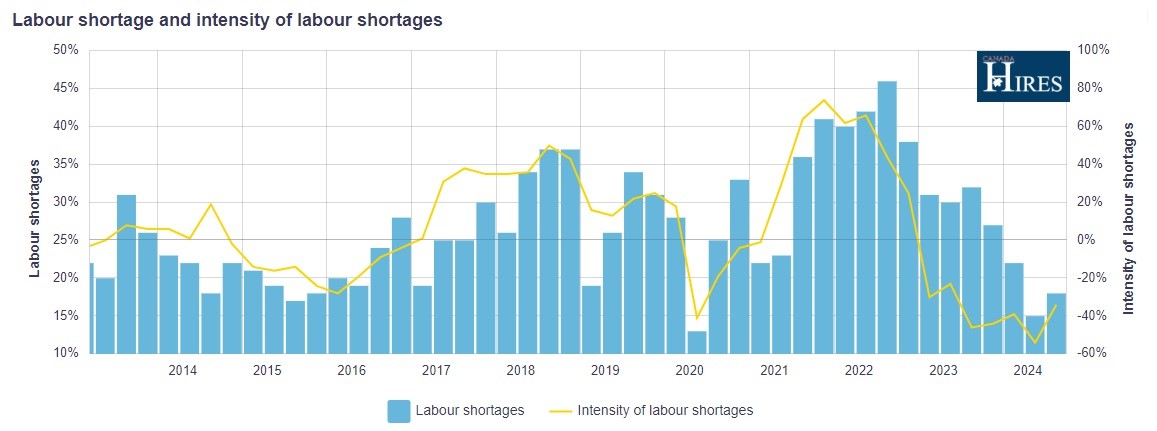
Labour shortages have been a persistent issue in Canada, with the graph highlighting fluctuations in both the rate of shortages and the intensity of shortages over the past decade. From 2013 to 2024, these shortages have trended upwards, particularly between 2020 and 2022, driven by pandemic-related disruptions, changes in the workforce, and other economic challenges.
However, as we move into 2024, we can observe a recent decline in the intensity of labour shortages, although overall levels remain elevated compared to historical trends. This ongoing challenge presents both risks and opportunities for businesses across the country, especially when coupled with shifts in fiscal and monetary policies aimed at encouraging economic growth.
Labour shortages, as depicted by the blue bars in the graph, have remained above 20% for much of the past decade, peaking during critical periods such as the COVID-19 pandemic. This shortage limits businesses' capacity to expand, meet customer demands, and innovate. The yellow line, which indicates the intensity of these shortages, mirrors these struggles, showing particularly heightened strain in 2021 and 2022.
In periods of labour shortages, businesses may face increased competition for talent, wage inflation, and reduced productivity. This creates a ripple effect, impacting the ability of industries like construction, healthcare, and technology to maintain consistent growth, leading to broader economic implications.
In response to economic challenges, including rising unemployment and slower growth, the Bank of Canada recently cut its overnight interest rate to 3.75%, down from its previous high of 4.25%
This move is a critical step toward alleviating some of the pressures businesses face by:
Lowering Borrowing Costs: A reduction in interest rates directly impacts the cost of borrowing for businesses. With cheaper access to credit, companies can finance expansion, invest in new technology, and enhance productivity despite labour shortages. This, in turn, can create more jobs as businesses grow.
Stimulating Investments: Lower interest rates also reduce the cost of capital, encouraging businesses to invest in infrastructure, research and development, and other areas that may have been previously constrained by higher borrowing costs. Increased investments in these areas can help companies optimize their existing workforce, potentially mitigating the impact of labour shortages.
Boosting Consumer Demand: A lower interest rate environment generally improves consumer confidence. As borrowing costs for mortgages, car loans, and other credit products fall, consumer spending may increase, driving demand for goods and services. This rise in demand incentivizes businesses to scale up operations, increasing the need for additional labour.
The combined trends of persistent labour shortages and falling interest rates create a delicate balance. While shortages remain a challenge, businesses now have the opportunity to leverage cheaper credit to optimize operations and invest in long-term growth. By adopting innovative hiring practices and exploring ways to upskill their existing workforce, businesses can not only address current shortages but also position themselves for sustained growth as the economic landscape improves.
Labour shortages in Canada will continue to require creative solutions from both the public and private sectors. However, the Bank of Canada's decision to cut interest rates offers a glimmer of hope for businesses looking to expand and hire. As borrowing costs decrease and investments rise, companies may find new opportunities to grow their teams, adapt to ongoing challenges, and thrive in the post-pandemic economy.
Q1: How can job seekers use the current labour shortage trends to their advantage when applying for jobs?
A1: Job seekers can use the labour shortage to their advantage by targeting industries and regions with the highest demand for workers. Highlighting transferable skills and being flexible with job roles can also make candidates more attractive. Additionally, focusing on upskilling in areas where there is a notable talent gap, such as technology or healthcare, can help candidates stand out.
Q2: How exactly do interest rate cuts stimulate hiring, and how does that benefit job seekers?
A2: Interest rate cuts lower borrowing costs for businesses, allowing them to invest in expansion, operations, and hiring. For job seekers, this means more job opportunities as businesses grow and need more employees. It also creates a more stable economic environment, encouraging companies to be more confident in their long-term hiring decisions.
Q3: Are there specific industries that are benefiting more from the current economic conditions, and should job seekers focus on these areas?
A3: Yes, industries such as technology, healthcare, and construction are particularly benefiting from the current economic conditions due to high demand and labour shortages. Job seekers should focus on these sectors if their skills align, as they are more likely to offer job opportunities, competitive salaries, and long-term growth potential.
Bank of Canada – Graph on Labour Shortage and Intensity of Labour Shortages in Canada.
Daily Hive – "BoC Rate Cuts and Implications for Homebuyers."
Canadian Mortgage Trends – "Interest Rate Forecasts for 2024: Lowering Mortgage Costs."
Scotiabank Economics – "BoC's 2024 Rate Cuts: Market Implications and Growth Opportunities."
Kelowna Real Estate – "Impact of Labour Shortages and Interest Rate Cuts on Canada's Housing Market."